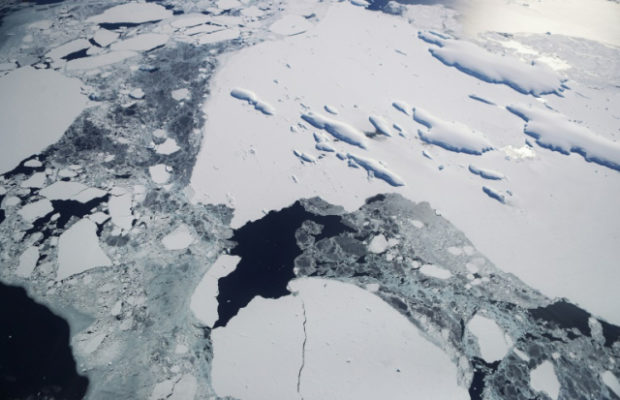Coming decades vital for future sea level rise—study

The Antarctic ice sheet contains enough frozen water to lift oceans several dozen meters and much depends on how it reacts to temperature rises. Image: MARIO TAMA – GETTY IMAGES NORTH AMERICA/AFP/File
How quickly humanity draws down the greenhouse gases driving global warming will determine whether sea levels rise half-a-meter or six times that, even if Paris climate pact goals are fully met, researchers reported Tuesday in a study.
“The trajectory of emissions in the next few decades will shape our coastlines in the centuries to come,” lead author Matthias Mengel, a scientist at the Potsdam Institute for Climate Impact Research in Germany, told AFP.
Every five years that elapse before carbon pollution peaks will add 20 centimeters to sea level rise in 2300, the study found.
“This is the same amount we have experienced so far since the beginning of the fossil fuel economy,” Mengel said by email.
The world collectively spews about 40 billion tonnes of CO2 into the atmosphere every year. After stalling for three years, emissions rose by two percent in 2017, dashing hopes they had peaked.
Article continues after this advertisementOn current trends, emissions could increase for at least another decade.
Article continues after this advertisementThe 197-nation Paris Agreement calls for capping global warming at “well below” two degrees Celsius (3.6 degrees Fahrenheit) and pursuing efforts to hold the line at 1.5°C.
Average global temperatures have already gone up by 1°C since the industrial revolution began.
The treaty also sets a less talked about but equally crucial goal: ensuring that, by the end of this century, our species stops adding CO2 to the atmosphere, a threshold known as “net zero emissions”.
Mengel and colleagues asked a deceptively simple question: by how much will the world’s oceans rise over the next two centuries if both these targets are achieved?
The most likely outcome, they found, was an increase of 70 to 120 centimeters (27.5 to 47 inches) by 2300, depending on when CO2 pollution peaks, how quickly it drops, and the date net zero emissions are achieved.
That’s probably enough to doom some low-lying island states and wreak havoc in the populated mega-deltas of Bangladesh, Vietnam, India and Egypt, but would at least leave more time to adapt.
Redrawing coastlines
Currently, some 100 million people live within a meter (three feet) of the high-tide level, leaving them vulnerable not only to sea level rise but evermore powerful storm surges.
The study also showed, however, that fulfilling the Paris mandate does not necessarily avert catastrophic change.
If carbon emissions don’t peak until 2035 and CO2 continues to leach into the atmosphere until 2090, for example, the ocean watermark could go up three meters by 2300, rendering continental coastlines unrecognizable.
And if the Paris temperature goal is not met, there is a small chance oceans would rise five meters.
The biggest wild card in predicting future sea levels is the Antarctic ice sheet, which contains enough frozen water to lift oceans several dozen meters.
Its western peninsula is especially sensitive to climate change.
“Large ice loss seems possible even under modest warming in line with the Paris agreement,” said Mengel. “A sea level rise of up to three meters by 2300 cannot be ruled out.”
Ocean uplift is also driven by the expansion of water as it warms, and runoff from melting glaciers.
Earth’s atmosphere responds far more quickly to cuts in greenhouse gas emissions than oceans. Indeed, scientists estimate that there is at least half-a-meter of “committed” sea level rise already in the pipeline, perhaps more.
“Even if we stop emitting today, the effects of our past emissions will be felt for centuries to come,” said Pete Strutton, an oceanographer at the University of Tasmania.
“Every year that we delay action has consequences for the future.”
Matthias Mengel acknowledged that the best-case projections in the study are “really optimistic”.
Despite voluntary, carbon-cutting pledges by virtually all the world’s nations, global temperatures are on track to rise 3°C above pre-industrial levels by 2100.
“In the end, the Paris Agreement will not be evaluated on what it promised or aspires to do, but on the change it managed to catalyze and the emissions reductions achieved in the real world,” said co-author Joeri Rogelj, a climate modeller at the International Institute for Applied Systems Analysis in Austria. NVG
RELATED STORIES:
Sea level rising faster, study
Earth marks new highs for heat, pollutants, sea level in 2016 – report